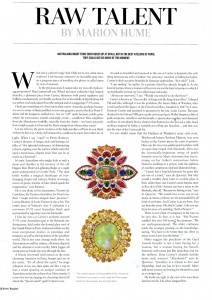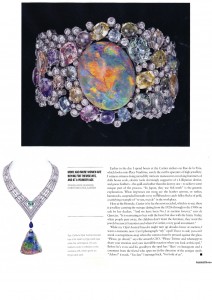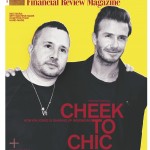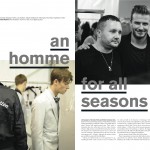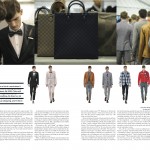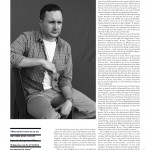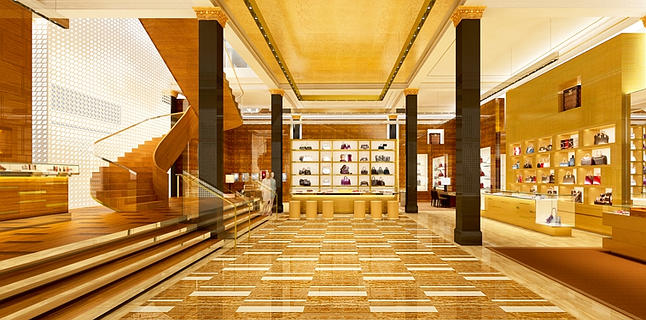Tag Archives: Louis Vuitton
An Homme For All Seasons – Australian Financial Review
An Homme For All Seasons
The way we travel obsesses Kim Jones. The menswear designer with Louis Vuitton, which started out making trunks, finds inspiration when journeying to the middle of nowhere. He tells Marion Hume what he learns from his 100 or so flights a year.
The Australian Financial Review | September 2013
The People’s Republic of Luxe – 10 Mag
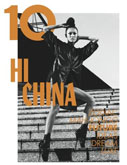
The People’s Republic of Luxe
10 Mag | Issue 41 November 2011
When I was a little girl, before you were born, China was the place they made cheap stuff. Now it’s the place where all the luxury labels have to have their snazziest stores in the world. When I was a teenager, China remained closed – they only let them out to scoop up all the medals at the Olympics. Now, of course, if you are in fashion, you have to go there to scoop up your share of an annual consumer expenditure estimated to top 1.3 trillion yuan (about £122 billion) by 2020.
by Marion Hume
And we’re not just talking Dior, Chanel, Vuitton. You want a yacht with that handbag? British yacht brand, Sunseeker is out there flogging its Manhattan 73 model for 31.4 million yuan (£3 million). You could toast your purchase with Chateau Lafite 1982 at 445,186 yuan (£42,115) Oh stop fretting, that’s for half a case. Did you think anyone would pay that much for a bottle?
When I started work, Hong Kong was the gateway to “Mainland China” as it was known (those in the know call it “the PRC” today). Back when Honkers was still a British colony, you could almost count the grains of rice in people’s dinner bowls as the plane swerved around mountains and tower blocks to touch down at Kai Tak, the world’s sixth most dangerous airport. Now, the PRC is peppered with super-dooper airports designed by “star-chitects”. But China’s billionaires don’t fly commercial, although some hire rather than own their own Gulfstreams. Price for Beijing-Shanghai return on a Gulfstream G550: 276,500 yuan (£26,157).
From the far south of Guangzhou, where Louis Vuitton has its largest Chinese flagship store, to the the old silk road staging post of Urumqi, the most inland city in the world – yup, they’ve got a Vuitton there too – China is fashion profit central, even if a recent store renovation is rumoured to have cost Vuitton in the eight digits. The first fashion person I knew who reached “real” China, as in Beijing, was sent by Zara to find a cheap production source. Now, Zara has 70 stores in the PRC.
The first time I went to Beijing, it was to interview newly-successful women, several of whom thought they were wearing designer clothes, but these were funny fake brands that I had never heard of. Then the fake market started to thrive and I seemed to always be clambering through some fat-filled restaurant kitchen, then down a back alley and into a room the size of a toilet pretending to be a customer. The criminal salesmen pretended to believe me as they took photographs of my (real) Fendi Selleria bag. The fake business shows no sign of slowing down as China’s love of luxury booms. The new trend is in counterfeiting an entire experience, although who knew there was anywhere on earth that they would welcome a completely fake branch of IKEA?
Even as recently as five years ago, the picture the photographer had to get was the “contrast shot” of the toothless guy parking his bicycle next to the Louis Vuitton superstore in Shanghai. The shoppers within were still so delighted in the newness of being able to express their individuality through fashion, that they would willingly stop and talk to a stranger with a tape recorder, a photographer and a translator. They told such sad stories of their Mao suit years. One shopper never knew her father. When her mother was pregnant, her parents had been sent to the country to be “re-educated” and they locked her father in a shed until he died. Her mother survived eating frogs and birds eggs. Another was once given a yellow silk shirt from abroad, which gave her great joy every time she looked at it – until her mother dyed it brown so she could get the use out of it. That woman – a very powerful woman – started to cry as she remembered that. The power of fashion is powerful indeed.
Now, the bulk of luxury shoppers – and there are more than 200 million young adults under 30 in the PRC – were born after The Cultural Revolution so have not “eaten bitterness” as their parents did. Far from envying their lifestyles, their mothers tend to encourage them. “If I dress a little bit sexy, she thinks I look beautiful,” one girl told me when I returned to Beijing in 2008. “I’m the youth she didn’t have.”
For the luxury tsars, China’s love of the new is a great plus. “They don’t have a generation before them to refer to style-wise, so they are daring with the choices they make,” one CEO told me, eyes ablaze. The rules are still being written in this high profit battle ground. Beijinger and Shanghainese girls like to write off those from the “second tier cities” as bumpkins who have just learned to say Vuitton, but that doesn’t stop those in cities you’ve hardly heard wanting designer bags. No surprise then that as well as opening stores everywhere, the likes of Chloe now have Chinese language blogs. Faye Wong, a Chinese singer and actress, does print campaigns for Céline. One of Louis Vuitton’s male models is Taiwanese-Canadian actor and model Godfrey Gao. No prizes for guessing (beyond those gorgeous cheekbones) why he got the gig.
It might be hard to believe this now, but British designers used to quake in their boots when the American department stores came calling. China is expected to be the second-largest consumer market in the world by 2015 and if the USA doesn’t pull its economy out of tailspin, it could come sooner. Guess which buyers get the champers and the Rose Bakery cupcakes these days? But forget any cliches about Chinese shoppers liking the logo-a-gogo stuff. The level of sophistication is obvious when you walk past racks of Vanessa Bruno, Maison Martin Margiela, Rick Owens at the Lane Crawford department store in Beijing.
A year ago, I got a call from Francois-Henri Pinault’s office. Would I like to join him on a trip to 10 Chinese cities, few of which I had actually heard of (and I’m up on Beijing, Shanghai, Shenyang, Hangzhou, Chengdu, Dalian…)? Alas, I was in a diamond mine in Australia (key global market for Tiffany? Yes, you got that one too) so had to pass on the PPR titan’s tempting invite, but I did once interview Pinault’s rival, Bernard Arnault of LVMH, in a penthouse suite in Beijing. Trying to get to Arnault, both the richest man in fashion and the richest man in France, when you are actually in France is well-nigh impossible. Yet in China, he was as relaxed and warm as a chilly billionaire can be, although he was probably totting up what you get when even 0.001% of a population headed towards 1.35 billion people wants Dior.
But you should never count your Chinese chickens. When Arnault’s mate President Sarkozy said he would be meeting the Dalai Lama (do, please Google exactly why Richard Gere is so passionate about Tibet), the Chinese ambassador in Paris apparently had the luxury titan quaking in his handmade Berlotti shoes at the thought of Chinese Vuitton customers asking for their money back.
Those customers get wooed. Last year it was the Dior extravaganza staged on the Bund in Shanghai; there was the “Culture Chanel” exhibition, the Fendi’s show on the Great Wall and the Ferragamo show within the Forbidden City. But it is not just about wooing the girls. One of the glories of modern China, if you are a luxury tycoon, is this is one of the few markets where men outdo women in their regard of expensive designer goods as trophies of success. Good news for Dunhill and Hugo Boss,
You can’t keep up with who is opening, who is expanding where. There’s Burberry’s upcoming Hong Kong megastore which promises to be a smart shopping destination for an annual 23 million Chinese tourists who come to town. Niche brands like Moncler are making a splash in Beijing, Miu Miu is expanding in Shanghai – the list goes on.
Susan Owens is a China expert whose blog, Paris Cherie, links the world of Paris fashion to Shanghai. She admits she can hardly post content up fast enough or keep track of the Western brands keen to snap up the services of Shanghai model, Du Juan.
What the Chinese luxury consumer is not madly interested in – up to now – is the vast nation’s sartorial past. “There’s no vintage—Chinese don’t wear old clothes,” someone told me. Hello Ralph Lauren, who visited China last year. Cue an autumn-winter 2011 collection of cheongsams inspired by the old silk road. When Ralph Lauren opened his first stores in Britain, back when Princess Diana was young, few thought his coals-to-Newcastle – or more precisely chintz-to-Downton Abbey -offering would work in a land where some people actually owned family silver. How wrong we were so expect to see fashion folk in the PCR dressing “Chinese”
Coming soon, more homegrown designers, more competition. And I leave you with this. In 1997, I was editing Vogue Australia, which meant I was “Asia Pacific” on the Paris show seating plans and thus in the worst seats in the house. Around me would be the first few fashion editors from the PRC. Where are they now? Locate Suzy Menkes and track along a couple of chairs, that’s where. All power to China.
Anatomy of a Maison – Australian Financial Review
Anatomy of a Maison
The Australian Financial Review | November 2011
In the Medieval age, the sight of a towering spire signalled a city of splendour. Today, it is cathedrals of retailing that indicate metropolitan status in the global pecking order. The December 3 opening, not of another Louis Vuitton store – there are already 460 of those worldwide – but of a much grander Louis Vuitton ‘Maison’ (of which there are just 13) proves Sydney must be a very smart town indeed. Kar-Hwa Ho is the man responsible for the latest Australian opening, as well as such landmark stores as Louis Vuitton Singapore, housed on its very own island. Vuitton’s design director for the Asia-Pacific region tells Marion Hume about the new maison in the company of the brand’s Paris-based director of architecture, David McNulty.
A CATHEDRAL FOR A SECULAR AGE
“Is that a compliment?” asks David McNulty. “I suppose fashion houses are becoming architectural theatre in the way opera houses were and cathedrals used to be. For us, there is always a question of visibility. We cannot be tucked away. We must be seen.” So how big a footprint is needed for a maison? “About 2000 square metres” says McNulty. Walk-ins are welcome at the Sydney Maison, because busy George Street means there’s nowhere to park, let alone a space for your limo to wait. But what of those Vuitton stores where you can’t walk in? The line at the Paris Champs Élysées flagship store often numbers in the hundreds. “It’s really not good to have people waiting,” protests McNulty, revealing that staff serve hot beverages to waiting crowds and the company sometimes lays on transport to the other five Vuitton stores in Paris, “but everyone wants to go to that one because it’s the biggest.”
IF WE BUILD IT, THEY WILL COME
To semaphore to the customer that a maison is more than just a place to pick up a monogram wallet, it helps if the building itself is jaw-droppingly attractive and the Sydney Maison certainly is chic. “But we don’t own the building, which means there are restrictions,” explains Ho. Even without these, sometimes the most arresting designs don’t get built. All the architecture models that didn’t make it are in the Vuitton head office, including one of shining metal rods by Zaha Hadid. “One day!” says Ho, wistfully. Do the challenges of preserving history lead to better stores? Not always. “While we’re not interested in destroying heritage buildings, our original concepts are usually better,” says McNulty, who adds that, sometimes, keeping the history can go too far. At the recently opened Milan Maison, he says, “there’s a really ugly mural on the wall. Really ugly. It has a preservation order on it so we built a wall in front of it, so some archaeologist in the future can come in and find it.”
MAKING AN ENTRANCE
There is no grander gesture than empty space, given retail rents are charged by the (astronomical) square metre and here is 59 sq m of glittering floor over which you must walk to reach the central altar of retailing. Walking directly ahead, you enter a ‘fast lane’ leading to what is known as the ‘hot zone’. Here’s where you find the bag that stars in the latest advertising campaign. “The bags that are the ‘fashion moment’ can always be seen from the entrance to the store,” says McNulty. But does one turn left or right? “We don’t want to control that,” he says. “We want to convey to the visitor that there are many things on offer; leather goods, travel, the men’s universe, the women’s universe.”
FAMILIARITY BREEDS EXCITEMENT
The aim is to attract a customer who knows exactly what to expect yet is also in search of novel retail entertainment. Uniform across all Vuitton stores is a colour palette of caramel and toffee, a reference to the checkerboard Damier canvas of 1888, which in turn led to Louis’s son, Georges, inventing the famous monogram canvas of 1896. And, rather as a cathedral has a smaller, perhaps more opulent, altar behind the main one – this only visible to those allowed to venture behind a parclose – so too does the Sydney Maison have its hidden treasure: literally, given the watch and jewellery sales area is tucked behind the ground floor’s central selling station. “The aim is to create a more intimate area, away from the flow,” Ho says.
GOING UP
In all retailing, the challenge is to encourage traffic to upper floors. That’s been somewhat easier since 1857, when the first commercial passenger elevator was installed in a New York City department store. Yet the Sydney Maison has just one customer lift. “It’s not necessary to have more,” McNulty says. “What tends to happen is that people walk around and discover the store by themselves, including taking the stairs. A sweeping staircase – all steel substructure and timber veneer – is visible centre-left as you enter the Maison, inviting you to mount a stairway to heaven – or more precisely menswear first and then, on the second floor, ‘women’s universe’ for fabulous fashion by Marc Jacobs.
HOLLYWOOD GLAMOUR
As Gloria Swanson knew, one must be well lit. While the primary function of store lighting is to make sure you can see everything, at Vuitton, spotlights are trained on the hottest products just as kliegs were once directed on a movie star’s cheekbones. “Whenever we can bring natural light into the store, we do,” says McNulty, who adds that, despite a menu of lighting options, sales staff always choose the brightest setting. But in the ‘try rooms’ (this is Vuittonese for what you and I usually refer to as a fitting room), it is you who control the light, via a panel that allows you to check an outfit under the noonday sun, at twilight and by night.
DESIGN FOR MEN
Even in equal Australia, men rarely shop midweek, which risks a very empty floor. The solution: stick menswear on the first floor so women must go past it and thus might think, “I’ll get him a belt to soften the blow of all the stuff I’ve bought for me.” And when men do shop? “If a man sees a mannequin with an outfit on it, he could well buy the [lot],” says McNulty. Expect to see rows of mannequins. The primary male quest is for shoes. Your shoe guy wants to choose shoes, sit down, try them and buy them. So the chairs here (just one of 10 different designs in use by Vuitton) are the optimum height and tilt for trying on footwear. This is less of a concern in China where, “they have no problem waiting for a seat to be freed up; they’ll do it standing on one foot and they’ll even try clothes on without using a changing room,” McNulty says.
VIP
When spending a penny (as opposed to $4500 on the latest Tiger clutch bag), every customer is a VIP – given the VIP loo is for you. But there’s VIPs and VVIPs. Tucked into a corner of the second floor is an area code-named ‘constellation’, as in ‘star’. Here, those who require additional privacy can be accommodated behind a closed door. As for the old saying that common folk sweat, the rest of us perspire and stars glow, here’s why: the VVIP area has its own dedicated air con. It’s here that the most exclusive service – the chance to get a bag in shapes and leathers of your choice – will be offered. It’s called ‘haute maroquinerie’ in Vuittonese. ‘Hot maroc’ in Sydney-speak? Don’t say we didn’t warn you.
SECRET DOORS
While an exceptional sales associate cannot actually walk through walls, she can tap a mirror to reveal a door that allows her to reach the tills. Cash-and-wrap is hidden from your view, “although we have to make sure that this works well with the flow of the selling ceremony,” says Ho. “You don’t want your salesperson to disappear for too long with your things while you are sitting around waiting.” But what about disappearing with one’s credit card while, even in restaurants, they bring the machine to you these days? “Mostly, people don’t mind,” Ho says. “But in Asia, customers follow their salesperson to the till. People pay cash and need a secure area to count it.”
ECOLOGY
Everything is as ecological as possible, from the certified woods you can see to the basement unpacking area you can’t, where paper and cardboard are stored. “Our Guam store is powered by solar panels,” Ho says. This not an option for Sydney where the building is rented.
AUSTRALIANA
While big-brand stores look somewhat the same around the world, Vuitton makes the effort to help shoppers remember what country they are in. In Auckland, the store features model lambs created by a Kiwi. In Jakarta, there are Indonesian lamps and stools. So for Sydney? The eagle-eyed will spot eucalyptus motifs played out in wood marquetry. Coming soon – although not in time for the opening – LV monogrammed surfboards should provide a clue.
WINDOW ON A NEW WORLD
Windows are an invitation, and a global mega-brand requires lavish displays. “From our standpoint, that means providing the right space and lighting and access,” says McNulty. The secret to quick changes? Panels that can move in and out and doors big enough to accommodate a window dresser carrying a zebra. That is not a joke. The windows in London’s Bond Street currently feature a herd of life-sized African fauna.

